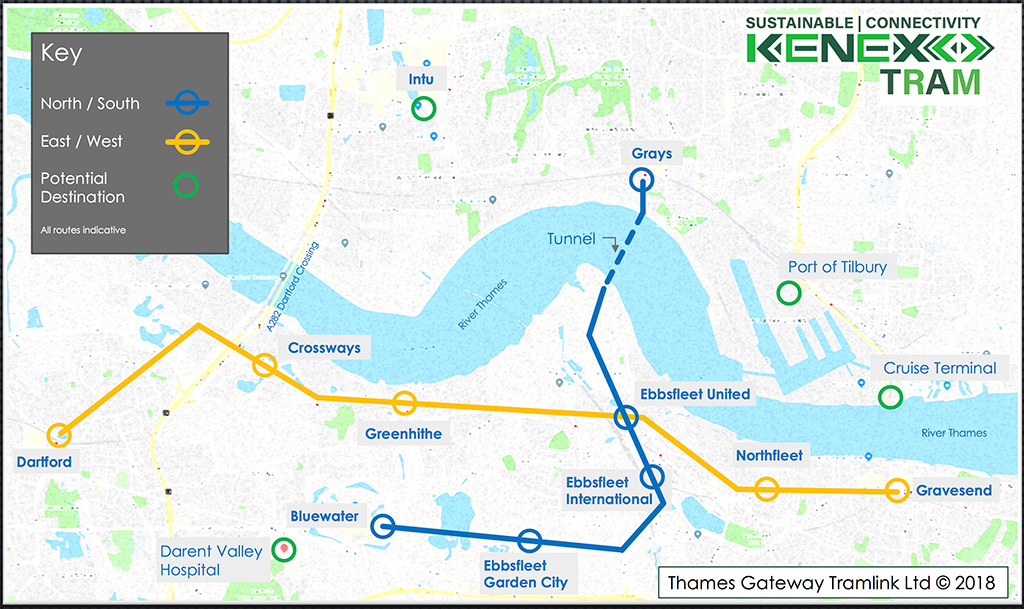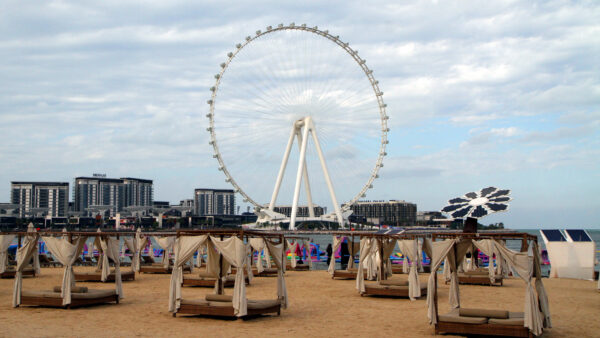Politicians in the English county of Kent have been presented with plans to cut traffic and air pollution by building an underwater tram link between Kent and Essex under the River Thames.
Danish consulting engineer Cowi told Kent councillors that a proposal to submerge a prefabricated tunnel under the river had “great merit” and was “certainly feasible”.
As done successfully in other countries, the tunnel would be built in sections offsite and floated into place.
Most of the tramline would be over ground, running from the Bluewater shopping mall in Kent and through Ebbsfleet before crossing the Thames to Grays in Essex.
Joining Cowi at the breakfast meeting were project backers Thames Gateway Tramlink Ltd. (Kenex), and Arriva buses, website KentOnline reports.
They said the tramline would cut congestion around the Dartford Crossing further east, presently the last crossing over the Thames. The area is affected by some of the highest levels of pollution in the UK.

Thames Gateway Tramlink Ltd.’s map of the proposed tunnel system
Gordon Pratt, managing director of Thames Gateway Tramlink, said the time was right to be looking at environment-friendly transport solutions.
“Having now had our tunnel feasibility … confirmed by international experts we are very pleased that another significant step forward has been achieved by the project,” he said.
“By following many other countries in not relying on a road tunnel KenEx can lower pollution and provide an efficient, inclusive and sustainable rapid transport solution for all.”
Damian McGirr, director of Danish consulting engineer Cowi, which has studied the proposals, said: “Based on present knowledge, construction of a new river crossing at the proposed location as an immersed tunnel appears feasible.
“When comparing with recently constructed immersed tunnels in Denmark, Sweden and the Netherlands, the site conditions for the KenEx tram appear well suited for an immersed tunnel. Ground conditions, environmental impact and navigational aspects, will of course influence the specific details around tunnel construction. However, from our initial observations during the site visit recently, we would expect that these can be addressed by suitable planning, design and construction.
“We consider that the proposal has great merit and is certainly feasible”.
Top image: The heavily congested Dartford crossing (Dreamstime)
Further reading
Comments
Comments are closed.







The question of technical feasibility is fine in itself, but this appears to argue justification on the basis of the relief from traffic density and pollution concentrated around the existing road crossing at Dartford (to the west, is it not?).
However, it is not clear what proportion of the traffic moves ‘locally’ between the station sites proposed or is part of broader and greater journeys. So what saving in these journeys and pollution is projected from these routes and where is the integration with other main line, underground or bus lines that will get the broader population out of its (future electric) cars?
As early as the 1950s a precast submerged twin lane tunnel was constructed under the South Arm of the Fraser River in Canada and is still operating today. But why a tram slow and low capacity Why not use London Underground trains. However the current track record of UK railway line construction projects does not provide a good track record of senior project management That said the Victorians did a good job of the underground. So have faith May be HNC qualifications are better than BScs
While building a tramline under the Thames, why not also do a favour to that other highly conjested part of London, ie Oxford Street. The Greater London Authority and Westminster City Council are having a quiet civil war, one wanting no public transport along Oxford Street, including no vehicular traffic, not even of any kind. The other, whilst wanting a vast reduction in public transport, some left, but conceding a pedestrian plazza at Oxford Circus. Both forgetting that very old ladies and gentlemen, and very young ladies and very young gentlemen want to be admitted to the entire length of Oxford Street, particularly, or even, at Christmas time. It is not conscionable to demand of tbe elderly, and of the very young that they undertake the two mile walk even at Christmas time.
Therefore some relenting on the part of the Transport authorities requires that they install a frequent (one and a half minute) high capacity (three carriage) tram service looping at each end (Marble Arch and Tottenham Court Road plazza).
Such would make happy shopping bunnies, of all ages , and stem before they happen complaints that the transport authorities are leaving the shopping public to fend for themselves at Christmas time.
This system of sinking pre-fabricated tunnel sections was very successfully used at Conway in North Wales about 20 years ago to take the road under the River Conway
Fantastic idea!! this revolutionises river crossing construction. There could also be a kinetic energy generation source attached to or built into the outside skin of the tunnel so all the construction materials used has a carbon ofset for the life of the tunnel could make it carbon positive if it’s life is long enough?
Also use of waste plastic encapsulated in the materials?